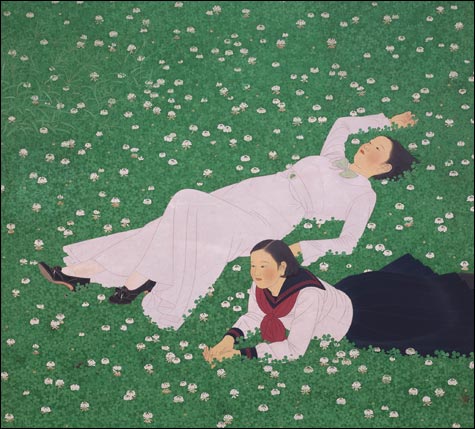
CLOVER Harumi Tateishi's scene could come out of Mary Cassatt. |
The paintings in "Shôwa Sophistication" at the Museum of Fine Arts are like the dreamiest travel posters you've ever seen. Produced in Japan during the 1930s, these images of pretty ladies and prettier countryside are so sweet, peaceful, and alluring that you can hardly imagine they were created while the nation was ramping up for "SHÔWA SOPHISTICATION: JAPAN IN THE 1930S" | MUSEUM OF FINE ARTS, 465 HUNTINGTON AVE, BOSTON | THROUGH NOVEMBER 8 "JOURNEYS EAST: ISABELLA STEWART GARDNER AND ASIA" | ISABELLA STEWART GARDNER MUSEUM, 280 THE FENWAY, BOSTON | THROUGH MAY 31 |
war. The mystery of that disconnect energizes the already splendid art."Shôwa" was a name given to Emperor Hirohito by the ministers of Japan's imperial council when he acceded to the throne upon the death of his father, Emperor Taishô, in 1926. "Shô" can be translated from Japanese as clear, bright, or enlightened; "wa" can mean peace, harmony, and reconciliation. So Shôwa, the label for both the emperor and his reign, is sometimes translated as enlightened peace — or Japan bringing enlightened peace.
The name suits these 19 placid paintings, all of which were acquired by the MFA over the past five years. But it's a curious title for the leader of a nation in the midst of an ambitious, military-driven imperial expansion. Some say Hirohito grew into it when after Hiroshima and Nagasaki he agreed, over the objections of his generals, to the unconditional surrender that the United States demanded.
During the 1930s, Tokyo was rebuilding and modernizing — which in many ways meant Westernizing — in the wake of a 1923 earthquake and fire. The military build-up was helping the country emerge from economic depression. Seeking to attract foreign tourism, the government constructed a national park system. Sports were encouraged — the emperor was an avid golfer and his brother was a skier and hiker. Department stores offered the latest in Paris sophistication.
Japanese art fell into two broad categories: Nihonga, or traditional Japanese painting, and Western-style modernism by Japanese artists who had studied in France and were inspired by the Impressionists, the Cubists, and Matisse. Guest curator Frederic Sharf, an MFA trustee, focuses on Nihonga works painted with mineral pigments and ink on the traditional materials of paper and silk. They blend softly the buttoned-up precision of traditional Japanese painting with hints of Western Art Deco streamlining.
Harumi Tateishi's Clover depicts two languid young women reclining in a field of clover, like something from Mary Cassatt. Hakkô Matsushima's catchy Snow (Yuki) shows a stylish, rosy-cheeked lady in a green visor, striped scarf, brown coat, and backpack pausing for a moment while skiing. She raises her hands above her head to shade her eyes — and to show off her elaborately patterned red, white, and blue mittens. The scene is rendered in a vivid illustration style (note the decorative pattern of white squares filling the sky); it could easily double as a ski-area ad.
Some scenes reflect Japan's entering and being at home in the modernized Western world. Shunkô Saeki's Tearoom painting of two uniformed waitresses with zombie expressions standing at attention next to a rack of potted plants speaks of the changing place of women in Japanese society. "Liberated" women came into the city from the country to find work and support themselves, independent of men. Tetsu Kasuda's A Stylish Beauty Dressed in a Kimono Standing Beside a Decorated Christmas Tree illustrates how in the 1930s Japanese adopted the Western holiday of Christmas as a secular time of gift giving — as well as a way to mark the anniversary of Hirohito's accession to the throne and the birth of his son Akihito (the emperor today).
Biichi Takata's screens show cormorants hovering over roiling waters and another bird perched on a boulder as the green sea crashes around it. Reimei Shindô's pair of screens, Foot of the Falls, depict the white rush of water splashing among the mossy green rocks and then coursing through a gorge behind a bent branch sprouting autumn gold leaves. The scenes evoke a tender, delicate mood — capturing both the surging force of nature and the refreshing calm of a holiday in the wilds.
Such pictures at first appear traditional, but Western influences are visible in the thickness and opacity of the paint (versus the thin washes of traditional Japanese art), the scale of both the works and their subjects (traditional screens might approach this size, but they tended to show many small elements rather than the life-sized figures here), and the way the works are presented (increasingly framed, rather than as scrolls or screens).
These paintings were produced mainly for local eyes; they were first displayed at government-sponsored exhibitions modeled on official French salons. They all come from the collection of Rikizo Hosokawa, who bought them to decorate a complex of wedding halls, restaurants, and saunas that he began to erect on the outskirts of Tokyo in 1931.